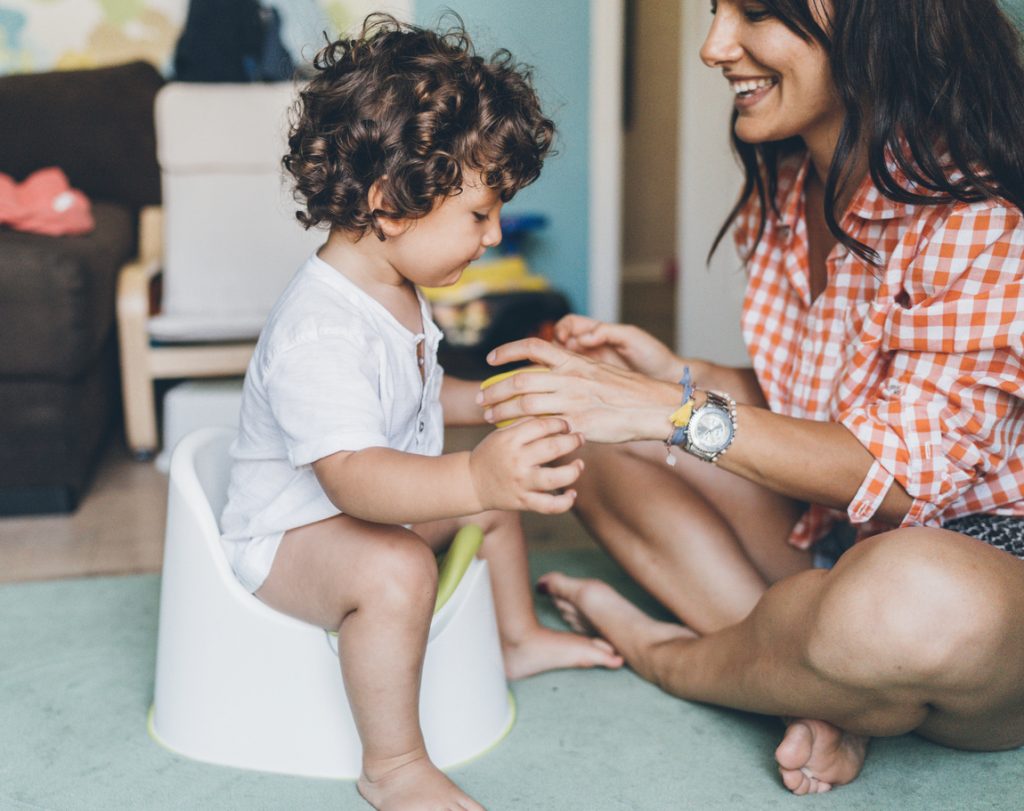For months now, I’ve been telling myself that I am about to experience the magical ease of toilet training my daughter. Other moms have told me repeatedly that this will happen: “Oh, girls toilet train so much earlier,” or “Boys just don’t care that much; girls do.” And I have been thinking back to the conversations about toilet training that I had with my son:
“Son, would you like to learn to go on the potty so that you don’t have to wear diapers and can wear underpants like a big boy?”
(Son) “No, Mom, I’ll do that when I’m older.”
(Inside voice, slightly panicky) “How much older are we talking about?”
But the days, weeks, and months continue to fly by, and, despite occasional flashes of apparent interest, my daughter continues to look at me with a combination of bemusement and disdain when I say, “Would you like to try to use the potty?” For now, let’s leave aside the heaps of gendered assumptions and expectations contained in the boy mom / girl mom toilet training conversation. For the practical task at hand, it’s clear that I can’t bank on a supernatural event to deliver me from the responsibility to help my daughter reach this mega-milestone. This is going to require some parenting.
Toilet training is daunting – as probably every one of the more than 7000 toilet training-related books on Amazon will tell you. Those 7000 books are also a clue that there are lots of different methods or suggestions for doing it the “right” or “best” way. Thankfully, I believe there are a few simple principles that can help sort it all out:
Understand Your Goals
Toilet training is something that a typically developing child must achieve at some point in order to meet cultural expectations for personal hygiene and participation in his or her broader society. In other words, children who fail to toilet train may be subject to social embarrassment and exclusion and will be unable to attend school or participate in extracurricular activities. As a parent, then, you have two main goals: (1) facilitate your child’s success in toilet training in a timeframe that helps him/her to continue his/her social development and expected educational trajectory, and (2) do so in a way that does not produce feelings of shame, guilt, and anxiety in your child. Looking for a third goal? (3) Don’t torture yourself in the process.
Align Your Strategy with Your Goals
The first step is to assess your child’s readiness for toilet training. Developmental readiness encompasses the ability to sense the need to pee or poop, the ability to communicate that sensation to a caregiver, the ability to sit steadily on the toilet seat – whether a toddler’s potty chair or modification of the regular toilet – and to devote his or her attention to the task at hand for a sufficient period of time. Some experts recommend the ability to pull his or her pants up and down, but initially your child will be accompanied to the toilet 100% of the time, and I consider this less necessary than the other requirements. In addition to this, your child should display interest in using the potty and a desire to be “clean” or be rid of diapers. Children display interest in a variety of ways, including following parents into the bathroom, asking questions, making observations and reporting when the diaper needs changing. Even after these signs appear, it may take weeks or months for the child to progress from curiosity to toilet training action, and it is important for the parent to be attuned to the child’s interest and open to his or her questions. It is helpful for parents to agree on what they consider to be appropriate terminology within the household for these bodily functions and to be consistent in their use in order to avoid creating confusion for the child.
When thinking about your timeline for toilet training, it is important to approach your child as an individual who is just trying to master a task. There is no evidence that the timing of toilet training has any association with intelligence or future success in life. My very bright, socially adept son may have been the last in his daycare class to complete toilet training (I’m not actually sure, since I made a conscious decision not to create comparisons), but he was within the same general timeline, completely within reported age norms, and well before he needed to enter the diaper-free zone known as preschool. Your child will eventually perceive the need to conform to this social expectation, and the process will be completed more quickly and painlessly on his/her timeline than on an imposed one. There is currently no evidence to support the idea that offering a reward – other than the intrinsic rewards of being “more grown up” and being rid of diapers – will create the necessary motivation to complete toilet training. Positive reinforcement even for small attempts at progress is encouraged – go ahead and be very liberal with your praise. Most importantly, discipline or shaming has no place in a successful toilet training process and is more likely to prolong or delay it. Negative comparisons to other children’s progress should be avoided, and once training is underway, the inevitable accidents should be met with a matter-of-fact change of clothing and an “It’s OK – we’ll get it the next time!” Frequent accidents are generally an indication that the child is not quite ready, and at that point you should resume the use of diapers until the child expresses interest in trying again. Remember, too, that nighttime dryness is generally achieved somewhat later than daytime dryness, and your child may require a diaper or “pull up” at night for some time after daytime toilet training is achieved.
In the service of not torturing yourself, it is fully acceptable to avoid toilet training methods that you feel will only aggravate you. Other parents have told me that they used the often-touted method of allowing their child to run around the house completely in the nude for a weekend, whisking him or her off to the toilet whenever it appeared that he or she needed to go or had commenced going. This worked for them, and kudos to them. The neat freak in me cannot even contemplate this slightly feral situation without horror, and I quickly eliminated it from the list of tools I might consider. Likewise, my children have shown more interest in the actual potty than in the potty chair, and I am more than happy not to have an Elmo-shaped chamber pot to empty and clean. Providing timed “opportunities” for success did make sense to me, however, and I frequently offered a trial of sitting on the potty around bath time and before bedtime. It may take some trial and error, but with patience and an intact sense of humor, you will find what works for you and your child.
Use Your Resources
You have more help at hand than you might think. Talk to other parents who have successfully toilet trained at least one child (the more the better); I’m frequently amazed at the ingenuity of the people in my life, and you might be amazed at the genius idea your best friend came up with. If your child attends daycare or has other caregivers when you are away from home, enlist their ideas and experience, and check in with them to see if you are being consistent and if they perceive that things are generally on track. Work with them to make incremental progress where you can and try to implement any daytime routines through the weekends when possible. Remember that your parents and your significant other’s parents somehow managed to toilet train you and your significant other, and they could have special insights into what might work for your child – or what might not work particularly well. And don’t forget that you can make use of the vast expertise of your pediatrician and his/her staff, many of whom have implemented electronic forms of communication for non-urgent issues and guidance.
I can’t promise that toilet training will be easy. But I can promise it will be successful…eventually. Good luck!






Comments